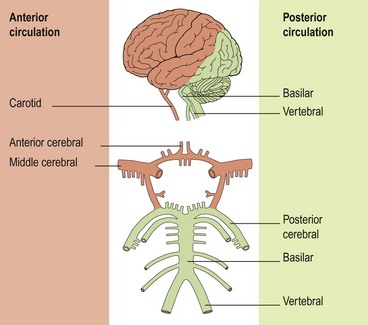Stroke II
Clinical features
The clinical manifestations of stroke depend on the area of the brain affected, which in turn depends on which blood vessel is affected. The anatomy of the blood vessels supplying the brain can be subdivided according to vessel size (large or small) and vessel site (anterior or posterior) (Fig. 1):
 Anterior circulation:
Anterior circulation: Posterior circulation:
Posterior circulation:The anterior circulation supplies the anterior two-thirds of the cerebrum, while the posterior circulation provides the supply for the occipital lobes of the cerebrum and the brain stem and cerebellum (Fig. 1).
Anterior circulation large vessel strokes
Partial anterior circulation stroke
Infarction in the territory of one of the branches of the MCA produces different combinations of deficits depending on the affected hemisphere (Fig. 2). Some of the common ones are: inferior branch = hemianopia – Wernicke’s aphasia if dominant, or constructional apraxia if non-dominant; superior branch = hemiparesis – Broca’s aphasia if dominant or neglect if non-dominant. Distal branches lead to cortical infarcts with weakness only of one limb or isolated higher function deficits.
Stay updated, free articles. Join our Telegram channel

Full access? Get Clinical Tree







